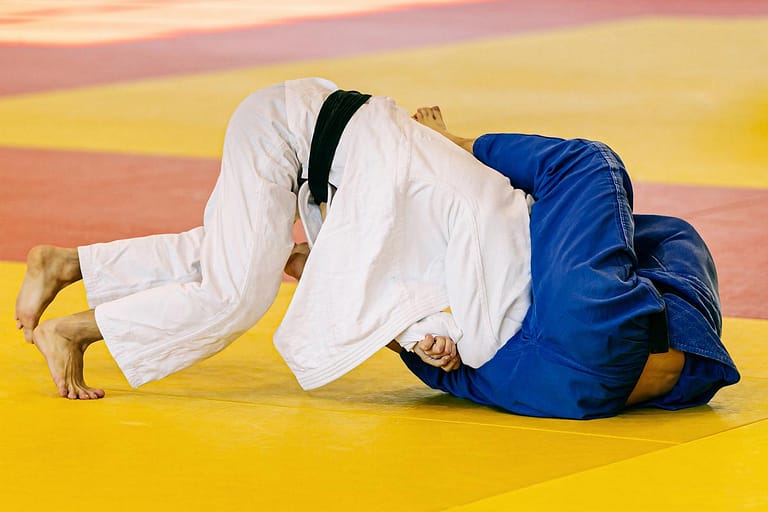What is Judo: A Gentle and Profound Way of Combat
What is judo? It is a Japanese martial art and an Olympic sport. It focuses on grappling and throwing techniques. “Judo” means “gentle way” in Japanese. It reflects the art’s principle of using an opponent’s strength against them.

Origins of Judo: From Japan to the World
Judo was founded by Jigoro Kano in 1882 at the Kodokan in Tokyo, Japan. Kano developed judo from traditional Japanese jujutsu. It emphasizes technique and leverage over brute strength. Judo quickly spread throughout Japan and then to the rest of the world.
Judo is a big deal in the world of martial arts. It’s not just about throwing people around – it’s got a rich history and philosophy behind it. Let’s dive in and check out how this Japanese fighting style became a global phenomenon.
The Birth of Judo
It all started with a guy named Jigoro Kano back in 1882. He was a smart dude who studied a bunch of different martial arts. Kano took the best parts of these styles. He mixed them to create something new and better. He called it “judo,” which means “gentle way” in Japanese.
Kano’s judo focused on using an opponent’s strength against them. The idea was to win a fight by throwing, pinning, or submitting your opponent, not by punching or kicking them. This made judo a more strategic and less violent martial art.
Spreading the Word
Kano didn’t keep judo a secret. He wanted to share it with the world. He started by teaching it in Japanese schools and universities. His students loved it and helped spread the word.
In 1886, Kano founded the Kodokan, which became the headquarters for judo. It was a place where people could come to learn and practice this new martial art.
Going Global
Judo really took off when it started spreading outside of Japan. Here’s a quick timeline:
- 1902: Judo reaches Europe
- 1903: First judo dojo opens in the United States
- 1909: Judo demonstrated at the Olympics in London
- 1932: Judo becomes an official event at the Olympics in Los Angeles
As judo gained popularity, it started to develop its own culture and traditions. Judo practitioners, or “judoka,” wear special uniforms, “judogi.” They must follow a strict code of etiquette on and off the mat.
Judo Today
Fast forward to today, and judo is practiced by millions of people all over the world. It’s not just a sport – it’s a way of life for many judoka.
| Continent | Number of Judo Practitioners |
|---|---|
| Asia | 20 million |
| Europe | 8 million |
| Americas | 3 million |
| Africa | 500,000 |
| Oceania | 200,000 |
Judo has come a long way since Kano first started teaching it in Japan. It’s a testament to the power of a good idea and the dedication of its practitioners. So next time you see someone getting thrown around on a judo mat, remember – it’s not just a fight, it’s a piece of history.
The Philosophy and Principles of Judo
Judo is based on two main principles:
- Seiryoku-Zenyo: Maximum efficiency with minimum effort
- Jita-Kyoei: Mutual welfare and benefit
These principles guide judokas to use their opponent’s energy against them. They also promote personal growth and harmony.
Judo Techniques: Throws, Pins, and Submissions
Judo techniques can be divided into three main categories:
- Tachiwaza: Standing techniques, primarily throws
- Newaza: Ground techniques, including pins, chokes, and joint locks
- Kata: Pre-arranged forms demonstrating principles and techniques
Some famous judo throws include:
- Seoi-nage: Shoulder throw
- Osoto-gari: Major outer reap
- Uchi-mata: Inner thigh throw
Judo Belt System: From White to Black
Judo uses a belt system to indicate rank and skill level. The belt colors, from lowest to highest, are:
| Belt Color | Rank |
|---|---|
| White | Beginner |
| Yellow | 5th Kyu |
| Orange | 4th Kyu |
| Green | 3rd Kyu |
| Blue | 2nd Kyu |
| Brown | 1st Kyu |
| Black | Dan ranks (1st to 10th) |
Judo Rules and Scoring in Competition
Judo matches take place on a mat called a tatami. Competitors wear a uniform called a judogi. They aim to score points by executing throws, pins, chokes, or joint locks. The scoring system includes:
- Ippon: Full point, awarded for a successful throw, pin, choke, or joint lock
- Waza-ari: Half point, awarded for a less perfect technique
- Yuko: Quarter point for a minor advantage (no longer used in international competition).
Penalties, called shido, can be given for rule violations. A hansoku-make (disqualification) is for serious offenses.
Judo’s Journey to the Olympic Games
Judo first appeared as an Olympic sport at the 1964 Tokyo Games. It has been a regular Olympic event since the 1972 Munich Games, with weight classes for both men and women. Judo is governed by the International Judo Federation (IJF). It has a strong presence in international sports.
Famous Judo Athletes and Their Achievements
Some notable judo athletes include:
- Teddy Riner (France): Two-time Olympic gold medalist and ten-time world champion
- Ryoko Tani (Japan): Two-time Olympic gold medalist and seven-time world champion
- Yasuhiro Yamashita (Japan): Olympic gold medalist and four-time world champion
These athletes have showcased the highest level of judo skill and have inspired countless others to take up the sport.

Judo for Self-Defense and Personal Growth
Beyond competition, judo is an effective self-defense system that teaches practitioners how to neutralize threats using leverage and technique. Judo is more than a sport. It is a self-defense system. It teaches how to use leverage and technique to neutralize threats.
Judo vs. Other Martial Arts: Key Differences
Judo is often compared to other grappling arts like Brazilian Jiu-Jitsu and wrestling. Judo is similar to other martial arts. But, it emphasizes standing techniques and using traditional uniforms. Judo, unlike karate or taekwondo, focuses on grappling and throwing at close range.

